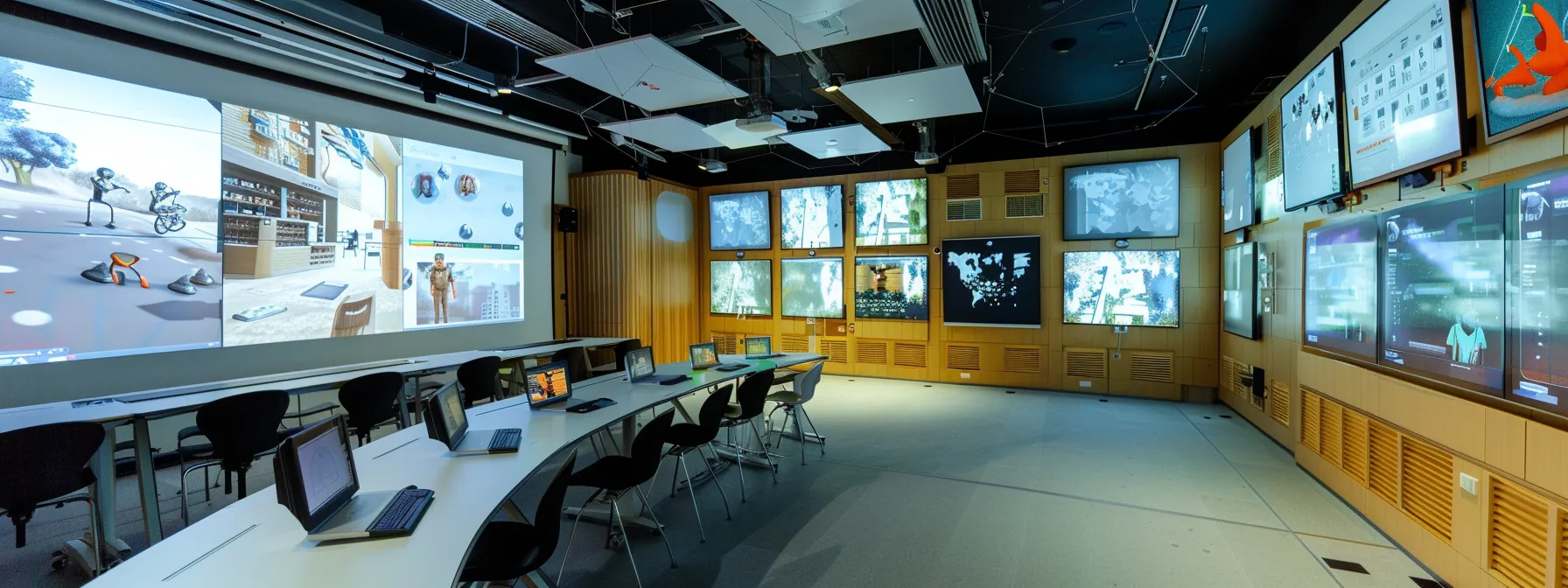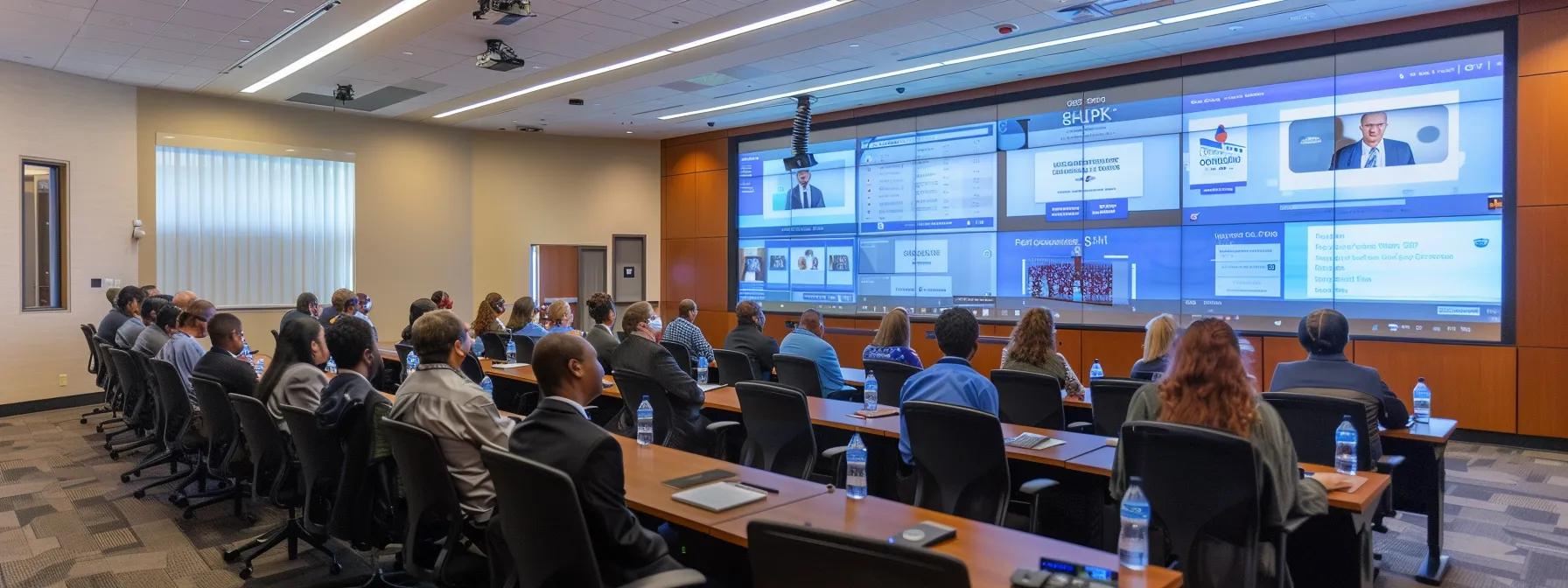Are you ready to redefine the classroom experience with the latest technological advancements? The transformative power of LMS platforms isn’t just a distant promise—it’s here, reshaping how educators and learners interact and achieve their goals. This post delves into the trends of 2025 that are enhancing LMS platforms, with a spotlight on adopting artificial intelligence and integrating virtual reality to create impactful, immersive education experiences. You’ll uncover how leveraging big data analytics bolsters your ability to tailor learning, thereby improving outcomes and confidence in each educational step. Moreover, we’ll explore the emerging necessity for cybersecurity in safeguarding cloud-based learning environments. With these insights, you’re set to navigate and capitalize on the new era of digital learning, enhancing user experience and moulding learner behaviour in powerful ways.
Adopting Artificial Intelligence in Modern LMS Platforms

As you explore the evolving landscape of learning management systems (LMS), you’ll discover the integral role of artificial intelligence (AI) in shaping a personalized and efficient learning environment. In this context, AI algorithms are not only advancing personalized learning but also streamlining administrative operations in LMS platforms. Embrace the future where machine learning automates mundane tasks, freeing you to focus on customer success and lifelong learning through sharable content object reference model (SCORM) compatibility. This seamless integration creates an LMS experience tailored to Contact Markanyx both learners and educators, resulting in a robust, adaptive path for education.
Improve Personalized Learning With AI Algorithms
With artificial intelligence driving content management systems, you gain an unprecedented level of personalization in learning. By analyzing learner data, AI algorithms adapt in real-time, presenting materials that cater to individual understanding and pace. This intelligent interface tailors your educational workflow, enabling a more compelling and user-centric experience, particularly when incorporating interactive elements like video.
Your journey through LMS platforms is transformed as AI guides and refines your learning strategy. The system’s nuanced insights into learner behavior mean each course is shaped to strengthen comprehension and retention, helping you carve out a path to success. Invest in an AI-enabled LMS and watch as it revolutionizes your training regimen, making every learning encounter more relevant and impactful.
Automate Administrative Tasks Through Machine Learning
Embrace the transformative power of machine learning to drastically simplify administrative tasks within your educational platforms. With the right LMS, tedious tasks such as data entry, grading, and schedule coordination become automated processes, affording you more time to cultivate a personalized learning environment. This leap in efficiency not only enhances the educational experience for learners but also streamlines project-based learning initiatives, fostering a stronger learning community.
Imagine an LMS that intuitively understands the needs of your education programs, where course management and learner assessment are neatly organized through smart algorithms. Machine learning in your LMS not only predicts learner performance but also provides actionable insights to better tailor your teaching methods. By harnessing this technology, you create a learning ecosystem that adapts to the nuances of individual and group educational journeys, reinforcing a personalized approach to education.
Artificial intelligence has reshaped how we learn, making LMS platforms smarter and more personalized. Now, imagine stepping inside your lessons as virtual reality invites you to not just learn, but to experience.
Integrating Virtual Reality for Immersive Education

The rapid fusion of virtual reality (VR) with learning management systems heralds a new era of immersive education. Creating real-world scenarios with VR technology enhances the depth of online learning, allowing experts to craft experiences that mirror actual work environments. This innovative approach to distance education breaks down geographical barriers, connecting you with immersive content that transcends traditional learning boundaries. Engage with machine learning-powered LMS platforms that deliver these transformative educational experiences, elevating your learning potential to new heights.
Create Real-World Scenarios With VR Technology
Embarking on integrating virtual reality into your LMS propels you into crafting scenarios that replicate real-world challenges. Through multimedia-centric VR environments, you enable learners to interact with complex systems as if at the helm of computer simulations – without the steep investment typically required for such hands-on experience. This emerging technology stretches the confines of traditional learning, instilling practical skills and confidence in users as they navigate lifelike tasks and procedures.
Your commitment to data security is paramount; hence, when VR aligns with your LMS, rest assured that sensitive information is safeguarded within immersive learning landscapes. By converging VR’s interactive potential with stringent data security protocols, you foster an educational enclave where learners delve into scenarios free from risk yet brimming with opportunity. This forward-leaning approach meshes emerging technologies with robust safety measures to revolutionize how knowledge is conveyed and applied.
Overcome Distance Barriers With Immersive Content
Virtual reality in learning management systems dissolves the boundaries of distance, forging a global community of practice with ease and efficiency. By incorporating immersive content, you ensure continuous engagement and reference, creating an educational experience that is not confined by geography but is rather unbounded and collaborative. Such advances in LMS technologies not only solidify knowledge sharing but also play a crucial role in maintaining strong employee retention rates by offering cutting-edge tools for professional development.
Leveraging blockchain technology within your LMS VR environments, you provide verifiable and secure learning experiences, heightening collaboration opportunities that were once hindered by physical distances. As you employ VR content, you nurture a thriving educational ecosystem where skills are honed and competencies are developed in a manner that mirrors in-person interactions. This innovative approach to learning fosters a robust community tightly knit through shared virtual experiences, anchored by the permanence and reliability of blockchain’s digital ledger.
As we leave the realm of virtual worlds behind, the tangible impact of data emerges. Now, let us see how big data analytics sharpens the edge of learning, transforming information into knowledge.
Utilizing Big Data Analytics to Improve Learning Outcomes

Embarking on the future of education, you now have the capacity to utilize big data analytics within your learning management system to dramatically improve learning outcomes. By analyzing student data, you can refine instruction and curriculum to new levels of efficacy. This advanced application empowers you to make data-driven decisions, optimizing the utility of your internet and open source learning tools to bolster usability. Whether you’re refining onboarding processes or adjusting modules, the insights you glean offer a compass for targeted development and enhanced educational experiences.
Analyze Student Data to Tailor Instruction
By scrutinizing student data, you uncover patterns and areas for improvement that are invaluable for tailoring instruction. This thorough analysis leads to refined content management, ensuring resources are aligned with learner needs. Efficient management of curriculum adjustments means your resources are well-spent, maximizing the return on investment in educational technologies.
Implementing universal design for learning becomes more attainable as data analysis illuminates diverse learning paths and preferences. You can adjust your teaching approach based on concrete evidence, creating a more inclusive environment that caters to all students. This strategic management of learner data fosters a rich, adaptive curriculum designed to meet the challenges of modern education head-on.
Make Data-Driven Decisions in Curriculum Development
Through the precise application of big data analytics in your learning management system, you enable a more tailored development of your curriculum. By integrating platforms like Totara, you can pinpoint where lectures need to be reinforced or modified to suit varied learning modalities, directly addressing the efficacy of educational content delivery.
In your quest to offer dynamic and responsive educational experiences, consider leveraging insights from data analysis to guide collaboration in tools like Slack, where real-time feedback from business courses can inform immediate curriculum adjustments. This data-centric approach ensures that learning materials are not just up-to-date but also relevant and beneficial to the goals of your learners.
Big data sharpens our understanding, yet learning is not chained to desks. Let’s step into the world of mobile learning, where flexibility meets knowledge at every turn.
Improving Mobile Learning for Flexible Access

As the methodology behind learning management systems evolves, the focus on mobile accessibility becomes increasingly critical. You need an LMS that provides a seamless user-friendly mobile interface, supporting diverse learning styles, including microlearning, for optimal immersive learning on the go. With advancements in database technologies and the integration of tools like email within LMS applications, you’re set to experience an education that is not only flexible but also deeply engaging.
Design User-Friendly Mobile LMS Interfaces
To bolster revenue and satisfy the diverse learning styles your audience embodies, ensuring that your LMS’s mobile interface is as navigable as it is comprehensive is key. Embrace the importance of policy-driven, personalized learning by designing with the end-user in mind. This means straightforward navigation structures and interactive features that facilitate entrepreneurship and independent learning routines without sacrificing depth or functionality.
Consider how a user-friendly mobile LMS interface can revolutionize personalized learning by understanding and adapting to individual user patterns. Such attention to detail allows for a tailored experience that supports various learning engagements, from microlearning sessions to comprehensive coursework. It’s this commitment to adaptivity and ease of use that leads to a learning platform prized for its results and embraced for its simplicity.
Support Microlearning Through Mobile Applications
Your learning design must adapt to the rapid pace of today’s educational needs, and microlearning through mobile applications answers that call. Imagine software that delivers bite-sized, easily digestible content ideal for collaborative learning, permitting you to engage and comprehend complex science concepts on the move. This approach to LMS platforms fosters a habit of continuous learning, making it easier for you to integrate education into your busy schedule.
LMS platforms are transforming to support the modular nature of microlearning, accommodating the increasing demand for flexible educational experiences. You benefit from a design that encourages brief sessions of engagement suited to your needs, enabling a sustained and impactful learning journey. In this evolving landscape, your ability to access tailored microlearning courses through mobile applications becomes a significant advantage in the pursuit of knowledge and professional development.
Mobile learning bends to your life, giving you knowledge wherever you go. Now imagine turning that learning into a game, a quest for knowledge that wakes the thirst for more.
Implementing Gamification to Increase Student Engagement

As you strive to keep learners engaged, integrating gamification within your LMS emerges as a potent strategy. Incorporating game elements into course design not only enriches the learning experience but also reinforces key skills through dynamic feedback. Coupled with tracking progress via gamified assessments, this method transforms traditional educational models into interactive, flipped classroom environments. Get ready to elevate your learning strategy as you delve into how these playful yet purposive elements can revolutionize microlearning and overall educational infrastructure.
Add Game Elements to Course Design
Introducing game elements into course design is a transformative strategy that engages you on a new level, particularly when learning complex subjects like mathematics or languages. As you interact with a mobile app that turns problem-solving into a quest or vocabulary building into a challenge, you enjoy a heightened sense of achievement and retention. This approach, enriched by a sharpened intelligence in course mechanics, reflects the shift in educational practices accelerated by the pandemic—leading to more interactive and enjoyable learning experiences.
Your motivation to learn spikes when faced with the rich, competitive elements that gamification brings to an online course. By earning badges, advancing through levels, and receiving instant, personalized feedback, your engagement mirrors that of a well-crafted game, making the mastery of new skills in mathematics or language less daunting. This powerful aspect of modern LMS design caters to the disruption in traditional education, allowing you to continue your learning journey unfettered by global challenges.
Track Progress With Gamified Assessments
As you incorporate gamification into your educational system, tracking progress with gamified assessments becomes a cornerstone of learner engagement. This method offers you real-time visibility into your advancement, aligning with the modern educational landscape where immediate feedback is crucial for continuous improvement. By engaging with interactive tutorials within the LMS, you’re provided with a clear pathway to measure and celebrate your learning achievements.
Moreover, in a system where customer service and teacher support are paramount, gamified assessments act as a dual tool. They not only serve as checkpoints for your academic progression but also supply educators with valuable data to personalize the learning experience further. This tailored approach ensures that whether you’re a novice seeking basic comprehension or an expert refining your skills, the educational content adapts to support your unique journey within the learning environment.
Engagement flourishes with gamification. Now, as we fortify the playground, let’s secure the skies—prioritizing cybersecurity in cloud-based LMS.
Prioritizing Cybersecurity in Cloud-Based LMS Solutions

In the dynamic sphere of cloud-based LMS, you face pivotal concerns regarding cybersecurity—a principal trend shaping the future of education in 2025. As you invest in LMS platforms, you must prioritize advanced security measures to safeguard user data, while maintaining full compliance with educational standards. Your efforts in bolstering cybersecurity keep the integrity of blended learning environments, offering peace of mind when managing budgets and fees. Ensuring robust protection against threats enables seamless automation, enhancing the efficacy of training programs. We now delve into how these security advancements not only preserve your data integrity but also support the sustainable growth of educational technologies.
Protect User Data With Advanced Security Measures
In the digital space where education intersects with technology, safeguarding your data takes precedence. Advanced cybersecurity measures are vital tools in cloud-based learning management systems, ensuring the protection of sensitive information. With the rise of the Internet of Things and increased connectivity, it becomes essential that the LMS you choose is fortified against potential breaches, keeping your knowledge base secure and your mind at ease.
Your mastery over the concept of cybersecurity within a learning environment will direct you toward LMS platforms that offer robust, state-of-the-art security features. When you select a system equipped with latest encryption protocols and intrusion detection mechanisms, you build a fortress around the vast trove of educational data. This proactive stance on cybersecurity empowers you to lead in delivering uncompromised, safe, and effective online learning experiences.
Maintain Compliance With Educational Standards
Ensuring your LMS adheres to rigorous educational standards is paramount, especially when weaving together the threads of educational technology and cybersecurity. When you integrate big data analytics and design thinking into the development of your cloud-based LMS, you create a sustainable platform primed for evaluation and improvement. This commitment to standard compliance solidifies the system’s reliability and builds trust among users, forming the bedrock of a secure educational ecosystem.
As you navigate the intricate framework of educational regulations, it is essential to infuse your cloud-based LMS with mechanisms that can adeptly handle the multiplicity of compliance requirements. Let your platform mirror sustainability in both content delivery and data protection, leveraging sophisticated security protocols that honor the privacy of learners while streamlining the audit processes. Through this harmonious blend, your educational technology will not only meet current standards but will be well-prepared for the regulatory changes the future may hold.
Conclusion
The future of learning management systems is here, and it’s transformational. From harnessing the power of AI, VR, and big data analytics to implementing gamification and mobile-first approaches, these trends are redefining how education is delivered. At Mechanics, we specialize in integrating these cutting-edge technologies into LMS platforms, creating personalized, engaging, and secure learning environments tailored to your organization’s needs.
Ready to embrace the future of education? Contact Mechanics today to explore how we can help implement these innovative solutions in your LMS. Let’s work together to revolutionize your learning experience and empower your organization to stay ahead of the curve.
Reach out to us directly—your next step in education starts now!







